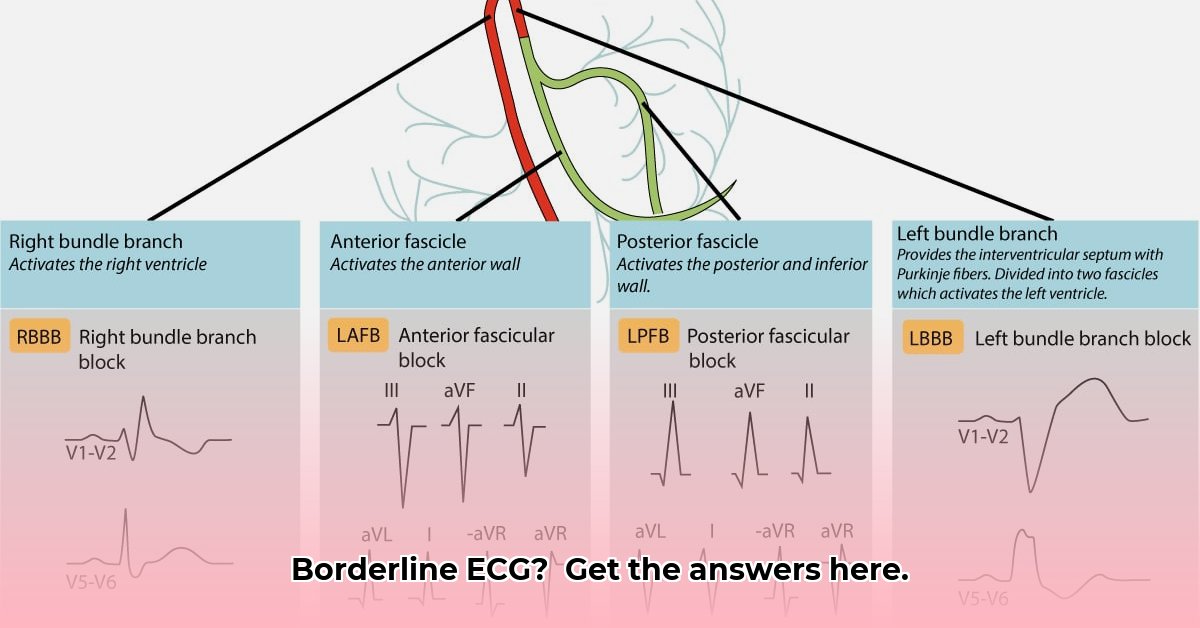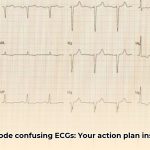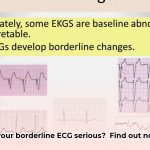Got a borderline ECG result from your checkup? It’s understandable to feel a little uneasy. This guide explains what that means, separating the really important stuff from the minor variations. We’ll break down what makes an ECG “borderline,” look at possible causes, talk about what it might mean for your health, and show you exactly what steps to take next, whether you’re a patient or a healthcare professional. We’ll cover everything from spotting the difference between a normal and a borderline ECG to better understand these results and what to do about them. For more in-depth information, check out this helpful resource on [borderline ECGs](https://www.mearnes.com/what-does-a-borderline-ecg-mean). Let’s make sense of this together so you can feel more confident and in control.
Borderline ECG in Physical Exam: What Does It Mean? Heart Rhythm Irregularities
Getting a “borderline” result on your electrocardiogram (ECG) during a physical exam can be unsettling. It’s like getting a “check engine” light on your car – it doesn’t necessarily mean a major problem, but it definitely needs attention. This means your ECG shows some slight changes that fall between what’s considered completely normal and clearly abnormal. Don’t panic! Let’s break it down.
Understanding the Fuzzy Zone
Think of it like this: you’re standing near the edge of a cliff. You’re not over the edge, but you’re close enough to make you a little cautious, right? A borderline ECG is similar. It alerts your doctor to something that warrants further investigation to rule out anything serious. It’s a signal that needs checking out, not a sentence.
An electrocardiogram (ECG or EKG) is a quick and painless test that records the electrical activity of your heart. Sticky patches called electrodes are attached to your chest, arms, and legs. These electrodes are connected to a computer, acting like sensors to pick up your heart’s electrical signals, which are displayed as waves on a monitor for your doctor to analyze.
Why a Borderline ECG? The Usual Suspects – Underlying Heart Conditions
Several factors can cause a borderline ECG reading. It’s not always a sign of a major heart issue. Some common culprits include:
- Minor Electrolyte Imbalances: Your body’s levels of important minerals like potassium, calcium, and magnesium can slightly affect your heart rhythm. An imbalance might show up on the ECG.
- Medications: Certain medications can temporarily alter your heart rhythm as a side effect. Consult with your doctor about potential alternatives if your ECG results are borderline.
- Stress and Anxiety: Believe it or not, stress and anxiety can affect your heart rate and rhythm, creating subtle changes on an ECG.
- Athlete’s Heart: For athletes who train intensely, a borderline ECG result is sometimes a perfectly normal adaptation of the heart to their strenuous activity. Their hearts are simply stronger and often beat a bit differently.
- High Blood Pressure: Elevated blood pressure can sometimes cause borderline ECG results.
- Unhealthy Lifestyle: Poor diet, smoking, and lack of physical activity can lead to borderline ECG results.
- Extreme Physical Activity: Heavy weight lifting and strength training can sometimes affect ECG readings.
- Underlying Heart Conditions (Potentially): In some cases, a borderline ECG might point towards an underlying heart condition, but it’s rarely a clear-cut diagnosis. Further testing is needed to confirm this.
What Happens Next? The Investigation Begins – Diagnostic Testing
A borderline ECG reading isn’t the end of the story; it’s the beginning of a more thorough evaluation. Your doctor will review the results with you and likely recommend some additional tests to get a clearer picture. These might include:
- Echocardiogram: This painless ultrasound of your heart creates detailed images of its structure and function, helping to assess its overall health. Think of it as a detailed “heart scan.”
- Stress Test: This involves monitoring your heart rate and rhythm while you exercise (on a treadmill or stationary bike). It helps doctors see how well your heart responds to physical exertion. It’s a way to see how your heart handles stress.
- Holter Monitor: This is a small, portable device you wear like a watch for 24 to 48 hours (or even longer). It continuously records your heart’s rhythm, giving your doctor a more comprehensive view of any irregularities that might only occur intermittently.
- Event Recorder: Similar to a Holter monitor, but you only activate it when you feel symptoms. This can be worn for weeks.
- Blood Tests: Checking electrolyte levels or markers of cardiac damage can help clarify concerns.
- Cardiac MRI: In some cases, a cardiac MRI may be recommended to get a more detailed look at the heart.
Putting It All Together: Interpreting the Clues – Heart Health Assessment
Interpreting a borderline ECG is not a simple yes or no answer. It depends on several factors, specific to you. Your doctor will consider:
- Your Symptoms: Are you experiencing any symptoms like chest pain, tightness, pressure, heartburn, difficulty breathing, shortness of breath, dizziness, lightheadedness, extreme fatigue, irregular or rapid heartbeat (palpitations), nausea, vomiting, or unexplained weight gain? These are critical pieces of the puzzle.
- Your Medical History: Do you have a family history of heart disease, high blood pressure, or high cholesterol? What medications are you currently taking? Your overall health status is a key factor.
- Your Age and Overall Health: A young, healthy individual with a borderline ECG might have a very different outlook than an older adult with pre-existing health conditions.
These details help shape how doctors interpret the ECG results. They paint a much more complete picture than the ECG reading alone.
Taking Charge of Your Heart Health: Proactive Steps – Lifestyle Modifications
Regardless of the final diagnosis after further testing, adopting a heart-healthy lifestyle is always a smart move. These changes can benefit everyone, regardless of their ECG results:
- Regular Exercise: Aim for at least 150 minutes of moderate-intensity aerobic activity or 75 minutes of vigorous activity per week.
- Balanced Diet: Focus on fruits, vegetables, whole grains, lean protein, and healthy fats. Limit processed foods, sugary drinks, and unhealthy fats. Aim for a balanced diet emphasizing fruits, vegetables, whole grains, lean proteins, and healthy fats while limiting processed foods high in sugar and salt.
- Stress Management: Find healthy ways to manage stress, such as yoga, meditation, deep breathing exercises, or spending time in nature. Techniques like mindfulness meditation or yoga can reduce stress levels which positively influences heart health.
- Quit Smoking: Smoking significantly increases your risk of heart disease.
- Limit Alcohol Consumption: If you drink alcohol, do so in moderation.
- Manage Existing Conditions: If you have high blood pressure, high cholesterol, or diabetes, work closely with your doctor to manage these conditions effectively.
Your Action Plan: A Step-by-Step Guide
| Step | Description |
|---|---|
| Discuss Results with Your Doctor | Have an open and honest discussion with your doctor about the borderline ECG results and any concerns you may have. Ask questions! |
| Undergo Recommended Testing | Follow your doctor’s recommendations and schedule any necessary additional tests. |
| Lifestyle Adjustments | Begin incorporating heart-healthy lifestyle changes into your daily routine. Small steps make a difference. |
| Regular Check-ups | Schedule regular check-ups with your doctor to monitor your heart health and track your progress. |
| Follow Medical Advice | Adhere to any treatment plans recommended by your doctor. |
| Proactive Risk Reduction | Actively work to lower your risk of heart disease through a healthy lifestyle and medical management. |
Important Note: This information is for general knowledge and doesn’t replace professional medical advice. Always talk to your doctor about your specific situation and health concerns. They can provide personalized recommendations based on your unique circumstances. Remember, a borderline ECG doesn’t automatically signal serious trouble, but it does warrant further investigation. Stay proactive, and work closely with your healthcare team.
How to Interpret Borderline ECG Results Based on Patient Symptoms and Risk Factors – Cardiac Assessment
Key Takeaways:
- A borderline ECG doesn’t provide a definitive diagnosis. Further testing is necessary.
- Patient history and symptoms are vital in interpreting borderline results.
- Risk factors significantly influence how a borderline ECG is evaluated.
- Various additional tests help clarify ambiguous ECG findings.
Understanding Borderline ECG Findings
A borderline ECG result—meaning slightly unusual but not clearly abnormal—can be unsettling. It’s like finding a slightly wobbly brick in a wall; you need to check if it’s a minor imperfection or a sign of a larger issue. About 20% of routine ECGs fall into this category, especially among patients without clear cardiac symptoms. Don’t panic! This doesn’t automatically mean something is seriously wrong.
The key to how to interpret borderline ecg results based on patient symptoms and risk factors is to consider the whole picture, not just the ECG alone. Think of it like a puzzle: the ECG is one piece, but your symptoms, medical history, lifestyle, and family history provide the other crucial pieces.
The Importance of Patient Symptoms – Vital Information
What
- Corporate Wellness Programs Cost Factors Impacting Your Company Budget - December 18, 2025
- Unpacking the Cost of Wellness Programs and Their Real Value - December 17, 2025
- How Much Do Wellness Programs Cost Businesses To Offer? - December 16, 2025
















